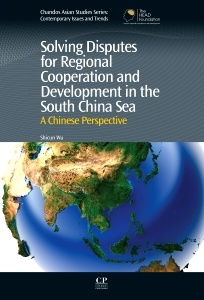Description
Solving Disputes for Regional Cooperation and Development in the South China Sea
A Chinese Perspective
Chandos Asian Studies Series
Author: Wu Shicun
Language: English
Subject for Solving Disputes for Regional Cooperation and...:
Publication date: 10-2018
200 p. · 15.5x23.2 cm · Paperback
Publication Abandoned
Publication date: 12-2013
200 p. · 15.5x23.2 cm · Hardback
Out of Print
Description
/li>Contents
/li>Biography
/li>Comment
/li>
List of figures and tables
List of abbreviations
Acknowledgements
Preface
About the author
Note on translations
Timeline of Chinese history
Chapter 1: Introduction
Abstract:
Purpose and significance
Territorial and maritime disputes in the South China Sea
Causes of the disputes
Structure of the book
Chapter 2: China’s sovereignty claims over the Nansha Islands: historical evidence
Abstract:
Discovery, naming and administration practices: from Spring and Autumn period to late Qing dynasty
Consolidation of Chinese sovereignty: from late Qing dynasty to post-Second World War
Conclusion
Chapter 3: China’s sovereignty claims over the Nansha Islands: a legal perspective
Abstract:
Discovery in international law
Successive administration (prescription)
Maritime legislation
International acknowledgement and recognition of China’s sovereignty
Protest against foreign invasions and fighting against foreign troops
Critical date
Discussion
The impact of UNCLOS
U-shaped line
Chapter 4: China’s dispute with Vietnam over the Nansha Islands
Abstract:
Vietnam’s sovereignty claim over the Nansha Islands and related maritime claims
Weaknesses in Vietnam’s claims
Confusion over the location administered by ‘Hoang Sa detachment/brigades’
Invalidity of succession from France
History of the China-Vietnam dispute over the Nansha Islands
Bilateral efforts on dispute settlement and future challenges
Conclusion
Chapter 5: China’s dispute with the Philippines over the Nansha Islands
Abstract:
Basis of the Philippines’ claims
Effective occupation and control
Assessment of the Philippines’ claims
History of the dispute between China and the Philippines
China-Philippine efforts for dispute settlement
Conclusion
Chapter 6: China’s disputes with Malaysia and Brunei over the Nansha Islands
Abstract:
Basis of Malaysia’s and Brunei’s claims
Assessment of Malaysia’s and Brunei’s claims
History of disputes with Malaysia and Brunei
China-Malaysia and China-Brunei efforts for dispute settlement
Conclusion
Chapter 7: Recent developments and regional cooperation in the South China Sea
Abstract:
Recent developments in the South China Sea
CLCS submission
National legislation and regulation
Incidents at sea
China-ASEAN: from DOC to COC
The involvement of non-claimant states
The Philippines versus China international arbitration
Regional cooperation: China’s commitment
Conclusion
References
Appendix: SCS island names
Index
- Highly pertinent in the context of the growing attention paid to potential international conflicts in the South China Sea
- Covers a wide range of topics including history, law, international politics, economy, diplomacy and military affairs
- One of the very few books written by a Chinese scholar in English in this area




